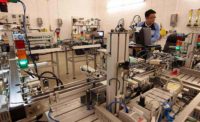RIT Center Focuses on Electronics Manufacturing

Rochester, NY, is home to several well-known companies, such as Bausch & Lomb, Eastman Kodak and Xerox. It’s also home to cutting-edge electronics manufacturing research, thanks to the Rochester Institute of Technology Center for Electronics Manufacturing and Assembly (CEMA).
The center offers undergraduate and graduate education, research and failure analysis services, workforce training, process development, consulting and laboratory rental for the electronics, optoelectronics and photonics packaging industries.
“Our mission is to be a quick-turnaround, value-added, service provider to companies and to enhance the performance of our partners through focused training and applied research,” says S. Manian Ramkumar, PhD, CEMA director and chairman of RIT’s Department of Manufacturing and Mechanical Engineering Technology.
“This center is the only one of its kind offering hands-on education at the undergraduate and graduate level in a state-of-the-art laboratory with industry-scale assembly and analysis equipment,” claims Ramkumar. “This organization is also the only one of its kind that provides hands-on training to industry, on campus or at the customer site, both nationally and internationally.”
CEMA was created in 2000 to support the electronics packaging industry and its workforce needs. With input and equipment support from an industry advisory council, Ramkumar and his colleagues developed the electronics packaging curriculum consisting of a three-course sequence. “It was an iterative process with industry that helped maintain the curriculum relevant to address industry challenges,” Ramkumar points out.
Ten years ago, with support from the Society of Manufacturing Engineers and the National Science Foundation, CEMA added optoelectronics and photonics packaging curriculum content and upgraded its laboratory equipment. Since then, the center has been able to secure grants from industry to conduct on-site and on-campus training workshops, in addition to a wide variety of applied research projects.
“This research focus and the ability to address current needs and challenges of the electronics manufacturing industry is our core competency,” says Ramkumar. “Our facility is equipped with state-of-the-art tools and capabilities and the ability to process and analyze newer materials.
“This is carried out with sustained interactions with equipment, material, substrate and component vendors,” adds Ramkumar. “In addition, faculty participate in numerous industry conferences to help maintain currency and follow technology trends to set the direction for CEMA.”
The 3,500-square-foot facility includes a comprehensive surface-mount technology and advanced packaging lab that features state-of-the-art tools for stencil printing, dispensing, placement, reflow, rework, inspection and analysis.
The Rochester Institute of Technology has long been a leader in electronics manufacturing research. For instance, several years ago, Ramkumar and his colleagues studied ways to improve product quality and reduce the environmental footprint of the electronics manufacturing process. Among other activity, they examined the pros and cons of using lead-free materials for soldering electronics to circuit boards.
“We are currently involved in projects related to 01005 passive component assembly, including stencil aperture design, manufacturing and finish,” says Ramkumar. “We’re also continuing to study fine-pitch area array package assembly, including stacked packages.”
The organization is conducting research pertaining to the reballing of area array packages and the performance of reballed components. Another R&D project currently underway is studying the effects of using a magnetically aligned Z-axis conductive adhesive as a low-temperature, lead-free solder replacement.
CEMA interacts with all segments of the electronics manufacturing supply chain. Equipment manufacturers have been generous in providing equipment donations and equipment on consignment.
Looking for a reprint of this article?
From high-res PDFs to custom plaques, order your copy today!





